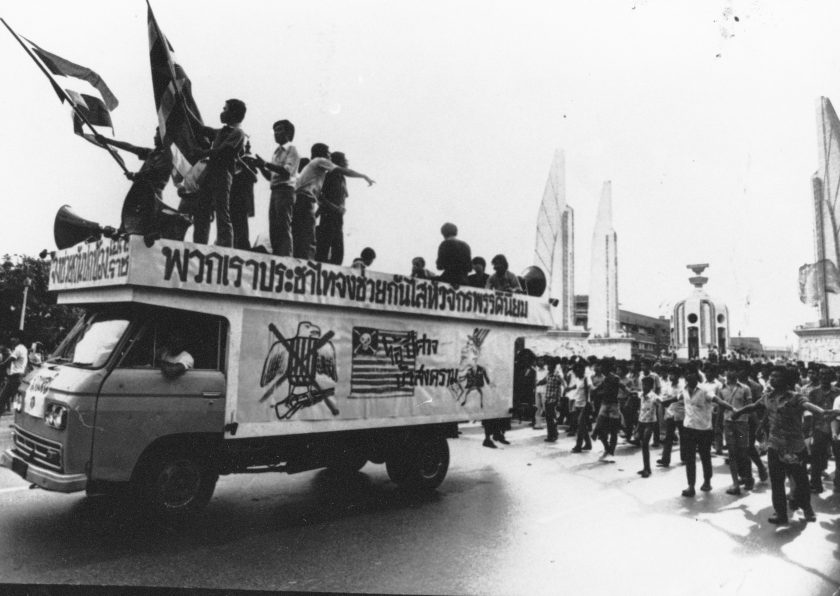1897
- - Most of the industrial laborers in Thailand at this time are Chinese immigrants, and they establish secret societies to take care of the well-being of their people.
-
- The government views Chinese workers as a threat to their system of rule and enacts the “Ang-Yee” law, a name that refers to a local Chinese group fighting for labor rights, to punish people who run illegal secret organizations.
1919
- - Thailand becomes a founding member of the International Labour Organization (ILO), but the government at the time refuses to adopt the ILO’s resolutions.
1932-World War II
- - In June 1932, the non-violent Siamese Revolution leads to a transitional government, as the system shifts from an absolute monarchy to a constitutional monarchy. The first permanent constitution is promulgated by the political party Khana Ratsadon, which is led by a mix of military and civil officers.
-
- - Under this government, Thawat Ritdeach is permitted to found Thailand’s first labor union, Samakom Kon-ngan Rodrang Hang Siam (The Siam Tramway Workers Union), to push for welfare reforms from employers.
-
- - Many labor stoppages take place, including strikes by Makkasan railroad workers, dock workers, rice mill employees and cement plant workers.
-
- - Professor and politician Pridi Banomyong joins Thawat and the labor movement, providing it with a political and economic strategy for the first time.
-
- - In 1938, field marshal Plaek Pibulsongkram becomes prime minister, beginning his reign as a de facto military dictator.
After World War II
- - In 1947, the Central Labor Union, a federation comprised of 64 unions, is founded.
-
- - It is estimated that only one percent of the workforce is involved in organized labor at this time, mostly in Bangkok. The rise of the Communist Party, however, increases the power of the labor movement.
-
- - The government, fueled by sinophobia and fearful of Communist influence in labor unions, forms Samakom Gummakorn Thai (the Thai Labor Union) to infiltrate and weaken rival groups, as well as make the labor movement more “Thai.”
-
- - Under Pibulsongkram, the legal quota of Chinese immigrants allowed into Thailand plummets from 10,000 per year to 200.
1956-1965
- - Workers reassemble under the Kum Gummakorn 16 Nuai (16 Units of Labor Group) name and again launch protests against labor conditions.
-
- - In 1956, the Council of Ministers (led by Pibulsongkram) approve a proposal to recognize May 1 as Labor Day. Thailand is allowed to celebrate the occasion for the first time, and tens of thousands march in the streets, rallying for land reform, social security benefits and return to parliamentary rule.
-
- - On Sep 16, 1957, field marshal Sarit Thanarat stages Thailand’s sixth coup d’etat. Labor gains are lost overnight, as Sarit abolishes labor organizations.
-
- - Under martial law, from 1958-1965, only 45 strikes occur, all spontaneous, demonstrating the brutal efficiency of the regime in stifling the labor movement.
1972-1981
- - In 1972, the government allows the formation of industrially-focused labor associations, but rather than being allowed to form industry-wide groups, they are limited geographically to provincial affiliations. Thai citizenship and good moral character are requirements to join one of these groups.
-
- - A student revolution in 1973 restores constitutional government. In the remainder of that year alone, 300 work stoppages occurr, as labor activists acquire newfound freedom of assembly.
-
- - Between 1973-1976, Thai labor groups form 138 unions, and a minimum wage is created.
-
- - In 1974, the Department of Labor begins to hold Labor Day celebrations at Lumpini Park.
-
- - In 1975, in a rapidly liberalizing regulatory environment, Thai workers are allowed to create national associations, and a loose federation of union groups is formed.
-
- - Public sentiment begins to turn against the same student-led movement that led to the downfall of military rule in 1973. The infamous, bloody crackdown on Oct 6, 1976, effectively ends the movement.
-
- - Under the new civilian government, hand-picked by a military advisory council, strikes and public assembles are outlawed. In 1977, just seven strikes are recorded. These remain outlawed until 1981, as the labor movement stagnates.
1980s-today
- - In 1998, Thailand passes the Labour Protection Act. This act lays out basic employee rights, including a two-tiered minimum wage, which is intended to be differentiated by province and industry.
-
- - The act is amended in 2018, expanding employee rights like maternity leave (now 98 days), statutory severance pay and gender equality in the workplace. The minimum wage also increases from B208/day to B330/day.
-
- - Despite gains over the years, Thailand continues to have a fractured labor movement, and workers have limited political clout.
-
- - According to the AFL-CIO-linked Solidarty Center, “Despite provisions in Thailand’s constitution that protect the right to form unions and bargain collectively, the government has failed to adopt International Labor Organization (ILO) Conventions 87 and 98, which cover these rights, and its labor law is not in compliance with ILO core labor standards. Thai labor law prohibits nearly 75 percent of the workforce from freedom of association and the right to collective bargaining. As a result, only 1.5 percent of Thailand’s nearly 40 million workers belong to unions.”
-
- - The Guardian reports that up to nearly 25 million people work in the country’s informal sector and lack social security protections.
Other sources: Labor Relations under Martial Law, The Thai Labor Movement, Thailand’s Second Triumvirate, The Thai Labour Movement: Strength Through Unity, The Thai Labor Movement During Political Crisis, The Nikom Foundation, Thai PBS

